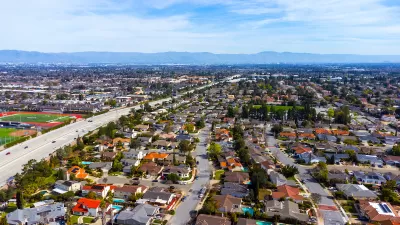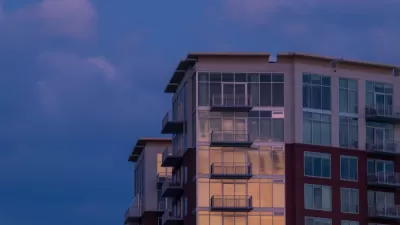Lafayette City Council Member Susan Candell penned an op-ed in support of a lawsuit to invalidate Senate Bill 9 by four Southern California cities, highlighting a recent supportive court filing by UCLA economic geographer Michael Storper.

On March 29, 2022, four cities in Los Angeles County, led by Redondo Beach, filed a writ of mandamus lawsuit against California Attorney General Rob Bonta in Los Angeles County Superior Courts, charging that Senate Bill 9, which permits the subdivision of single-family lots, violates the California Constitution in that it takes away the rights of charter cities to have control of local land use decisions.
[Related: More SB 9 Drama: L.A. County Cities Sue California, April 4, 2022. See additional posts tagged SB 9 dating back to August 2021.]
“In enacting Senate Bill 9 ('SB 9') in 2021, the State of California eviscerated a city’s local control over land use decisions and a community-tailored zoning process,” states the attorney acting on behalf of the petitioner city of Redondo Beach, joined by the cities of Carson, Torrance and Whittier, in the introduction of the 57-page filing [pdf].
In essence, SB 9 eliminates local authority to create single-family zoning districts and approve housing developments, a right that has existed for practically a century.
The Mercury News commentary
Lafayette City Council member Susan Candell, one of a very long list of elected city leaders in California who have endorsed a related ballot initiative effort launched by SB 9 opponents known as Our Neighborhood Voices, reported in her commentary for The Mercury News that Professor Michael Storper of UCLA’s Luskin School of Public Affairs, had filed a legal declaration [pdf] in support of the SB 9 lawsuit.
[Related: Ballot Initiative Could Overturn California's Zoning Reforms, February 15, 2022]
“Storper agrees based on his 2019 paper, and he is willing to testify under oath to prove that the currently popular narrative supporting the state’s policies is unabashedly untrue,” writes Candell.
He says the current narrative is “fundamentally flawed and lead(s) to simplistic and misguided policy recommendations” and actually harms residents and communities due to gentrification and displacement.
Storper says that the states’ erroneous narrative “diverts attention away from the real need to address housing affordability for low- and moderate-income groups already residing in the prosperous metropolitan regions.”
Storper came in first in last year's “Annual Google Scholar Citation Data for Planning Faculty,” reported Planetizen managing editor, James Brasuell, on Jan. 26, 2022.
Leading the number of citations is Michael Storper at the University of California, Los Angeles (UCLA), a controversial author and researcher who has provoked direct criticism on multiple occasions on Planetizen.
Update: Our Neighborhood Voices ballot initiative [November 2024]
In addition to highlighting Storper's support for the SB 9 lawsuit, Candell also promotes the ballot initiative that would amend the state constitution to prevent state preemption in local planning.
The only solution is to pass a constitutional amendment that would allow cities to override the state laws that are failing to solve our affordability and homelessness crisis — the Our Neighborhood Voices Initiative.
As noted earlier, the effort was described in the February 15, 2022 post, “Ballot Initiative Could Overturn California's Zoning Reforms: The 'mother of all NIMBY initiatives' is seeking signatures to qualify for the statewide ballot in California.”
In fact, Candell was one of seven proponents who submitted the “Request for Circulating Title and Summary” [pdf] to the initiative coordinator of the State Attorney General's office on July 13. If the measure qualifies, it would appear on the November 2024 ballot.
Article 34 repeal ballot confusion
“This constitutional amendment is expressly intended to authorize local laws to override conflicting state land use planning and zoning statutes,” states the last paragraph of the first section of the 6-page initiative [pdf]. However, the penultimate section simply states, "Article XXXIV of the Constitution of the State of California is repealed.”
Ballotpedia, the nonprofit organization that tracks most ballot measures in the U.S., has titled the Our Neighborhood Voices ballot measure, “California Authorize Local Land Use and Planning and Repeal Article 34 Initiative” (2024).
The California Authorize Local Land Use and Planning and Repeal Article 34 Initiative may appear on the ballot in California as an initiated constitutional amendment on November 5, 2024.
The ballot measure would repeal Article 34 of the state constitution, which requires local voter approval via a ballot measure for federal and/or state government-funded housing projects classified as low rent. The initiative would also authorize local laws related to land use, planning, and zoning to supersede state laws if they are enacted by the local electorate.
The repeal of Article 34 of the California Constitution, the subject of three posts on Planetizen since 2019, will appear in a measure by itself on next year's ballot, a result of the passage of Senate Constitutional Amendment (SCA) 2 by Sen. Ben Allen (D--Santa Monica) on Aug. 31, 20222, though exactly when appears to be unsettled.
“The measure will ask voters to do away with Article 34 of the California Constitution, which requires voter approval before public housing is built in a community,” reported Liam Dillon for the Los Angeles Times on Sept. 2, 2022.
Article 34, which passed in 1950, stymied low-income housing construction in California for decades and continues today to add to the cost and uncertainty of building affordable housing.
While other states have had and repealed laws that called for a public vote before the construction of low-income housing, only California’s Constitution currently requires voter approval for public housing.
March or November?
According to Ballotpedia: “The California Remove Voter Approval Requirement for Public Low-Rent Housing Projects Amendment is on the ballot in California as a legislatively referred constitutional amendment on November 5, 2024.”
A “yes” vote supports amending the California Constitution to repeal Article 34, which requires local voter approval via a ballot measure for federal and/or
state government-funded housing projects classified as low rent.
The Secretary of State's webpage, “Qualified Statewide Ballot Measures,” on Sept. 7 indicates it will appear on the March 2024 ballot as a result of the passage of SCA 2 (Allen) Public housing projects. (Res. Ch. 182, 2022) (PDF). However, a bill to move the measure, along with ACA 5 (Low) Marriage equality. (Res. Ch. 125, 2023) (PDF) which has also qualified for placement on the March 2024 ballot, to the November 2024 ballot has passed both houses and will be read for a third time on Sept. 8.
See Dillon's piece in the LA Times for more information on Sen. Ben Allen's bill and the effort to get it approved.
As for the confusion of having two ballot measures ask voters to repeal Article 34, look for future clarification in the comment section below.
FULL STORY: Opinion: Popular California housing narrative upended by planning expert

Manufactured Crisis: Losing the Nation’s Largest Source of Unsubsidized Affordable Housing
Manufactured housing communities have long been an affordable housing option for millions of people living in the U.S., but that affordability is disappearing rapidly. How did we get here?

Americans May Be Stuck — But Why?
Americans are moving a lot less than they once did, and that is a problem. While Yoni Applebaum, in his highly-publicized article Stuck, gets the reasons badly wrong, it's still important to ask: why are we moving so much less than before?

Using Old Oil and Gas Wells for Green Energy Storage
Penn State researchers have found that repurposing abandoned oil and gas wells for geothermal-assisted compressed-air energy storage can boost efficiency, reduce environmental risks, and support clean energy and job transitions.

Updating LA’s Tree Rules Could Bring More Shade to Underserved Neighborhoods
A new USC study finds that relaxing Los Angeles’ outdated tree planting guidelines could significantly expand urban tree canopy and reduce shade disparities in lower-income neighborhoods, though infrastructure investments are also needed.

California's Canal Solar Projects Aim to Conserve Resources and Expand Clean Energy
California’s Project Nexus has begun generating electricity from solar panels installed over irrigation canals, with researchers and state agencies exploring statewide expansion to conserve water and boost clean energy production.

HHS Staff Cuts Gut Energy Assistance Program
The full staff of a federal program that distributes heating and cooling assistance for low-income families was laid off, jeopardizing the program’s operations.
Urban Design for Planners 1: Software Tools
This six-course series explores essential urban design concepts using open source software and equips planners with the tools they need to participate fully in the urban design process.
Planning for Universal Design
Learn the tools for implementing Universal Design in planning regulations.
Heyer Gruel & Associates PA
City of Moreno Valley
Institute for Housing and Urban Development Studies (IHS)
City of Grandview
Harvard GSD Executive Education
Salt Lake City
NYU Wagner Graduate School of Public Service
City of Cambridge, Maryland





























